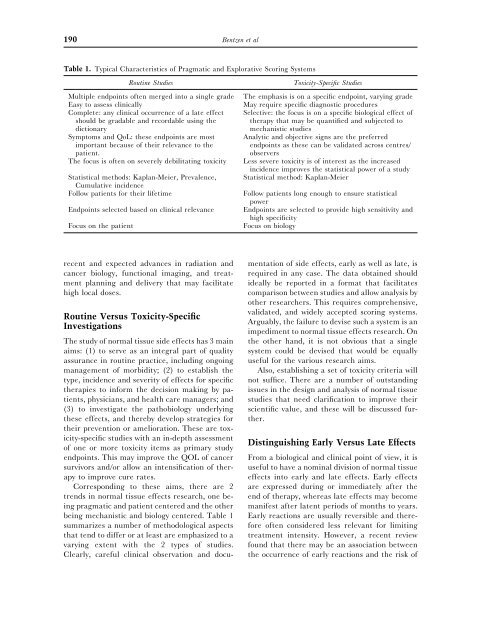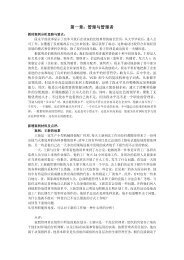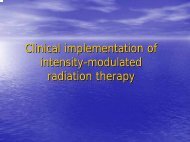Normal Tissue Effects: Reporting and Analysis
Normal Tissue Effects: Reporting and Analysis
Normal Tissue Effects: Reporting and Analysis
You also want an ePaper? Increase the reach of your titles
YUMPU automatically turns print PDFs into web optimized ePapers that Google loves.
190 Bentzen et al<br />
Table 1. Typical Characteristics of Pragmatic <strong>and</strong> Explorative Scoring Systems<br />
Routine Studies<br />
Multiple endpoints often merged into a single grade<br />
Easy to assess clinically<br />
Complete: any clinical occurrence of a late effect<br />
should be gradable <strong>and</strong> recordable using the<br />
dictionary<br />
Symptoms <strong>and</strong> QoL: these endpoints are most<br />
important because of their relevance to the<br />
patient.<br />
The focus is often on severely debilitating toxicity<br />
Statistical methods: Kaplan-Meier, Prevalence,<br />
Cumulative incidence<br />
Follow patients for their lifetime<br />
Endpoints selected based on clinical relevance<br />
Focus on the patient<br />
Toxicity-Specific Studies<br />
The emphasis is on a specific endpoint, varying grade<br />
May require specific diagnostic procedures<br />
Selective: the focus is on a specific biological effect of<br />
therapy that may be quantified <strong>and</strong> subjected to<br />
mechanistic studies<br />
Analytic <strong>and</strong> objective signs are the preferred<br />
endpoints as these can be validated across centres/<br />
observers<br />
Less severe toxicity is of interest as the increased<br />
incidence improves the statistical power of a study<br />
Statistical method: Kaplan-Meier<br />
Follow patients long enough to ensure statistical<br />
power<br />
Endpoints are selected to provide high sensitivity <strong>and</strong><br />
high specificity<br />
Focus on biology<br />
recent <strong>and</strong> expected advances in radiation <strong>and</strong><br />
cancer biology, functional imaging, <strong>and</strong> treatment<br />
planning <strong>and</strong> delivery that may facilitate<br />
high local doses.<br />
Routine Versus Toxicity-Specific<br />
Investigations<br />
The study of normal tissue side effects has 3 main<br />
aims: (1) to serve as an integral part of quality<br />
assurance in routine practice, including ongoing<br />
management of morbidity; (2) to establish the<br />
type, incidence <strong>and</strong> severity of effects for specific<br />
therapies to inform the decision making by patients,<br />
physicians, <strong>and</strong> health care managers; <strong>and</strong><br />
(3) to investigate the pathobiology underlying<br />
these effects, <strong>and</strong> thereby develop strategies for<br />
their prevention or amelioration. These are toxicity-specific<br />
studies with an in-depth assessment<br />
of one or more toxicity items as primary study<br />
endpoints. This may improve the QOL of cancer<br />
survivors <strong>and</strong>/or allow an intensification of therapy<br />
to improve cure rates.<br />
Corresponding to these aims, there are 2<br />
trends in normal tissue effects research, one being<br />
pragmatic <strong>and</strong> patient centered <strong>and</strong> the other<br />
being mechanistic <strong>and</strong> biology centered. Table 1<br />
summarizes a number of methodological aspects<br />
that tend to differ or at least are emphasized to a<br />
varying extent with the 2 types of studies.<br />
Clearly, careful clinical observation <strong>and</strong> documentation<br />
of side effects, early as well as late, is<br />
required in any case. The data obtained should<br />
ideally be reported in a format that facilitates<br />
comparison between studies <strong>and</strong> allow analysis by<br />
other researchers. This requires comprehensive,<br />
validated, <strong>and</strong> widely accepted scoring systems.<br />
Arguably, the failure to devise such a system is an<br />
impediment to normal tissue effects research. On<br />
the other h<strong>and</strong>, it is not obvious that a single<br />
system could be devised that would be equally<br />
useful for the various research aims.<br />
Also, establishing a set of toxicity criteria will<br />
not suffice. There are a number of outst<strong>and</strong>ing<br />
issues in the design <strong>and</strong> analysis of normal tissue<br />
studies that need clarification to improve their<br />
scientific value, <strong>and</strong> these will be discussed further.<br />
Distinguishing Early Versus Late <strong>Effects</strong><br />
From a biological <strong>and</strong> clinical point of view, it is<br />
useful to have a nominal division of normal tissue<br />
effects into early <strong>and</strong> late effects. Early effects<br />
are expressed during or immediately after the<br />
end of therapy, whereas late effects may become<br />
manifest after latent periods of months to years.<br />
Early reactions are usually reversible <strong>and</strong> therefore<br />
often considered less relevant for limiting<br />
treatment intensity. However, a recent review<br />
found that there may be an association between<br />
the occurrence of early reactions <strong>and</strong> the risk of
















